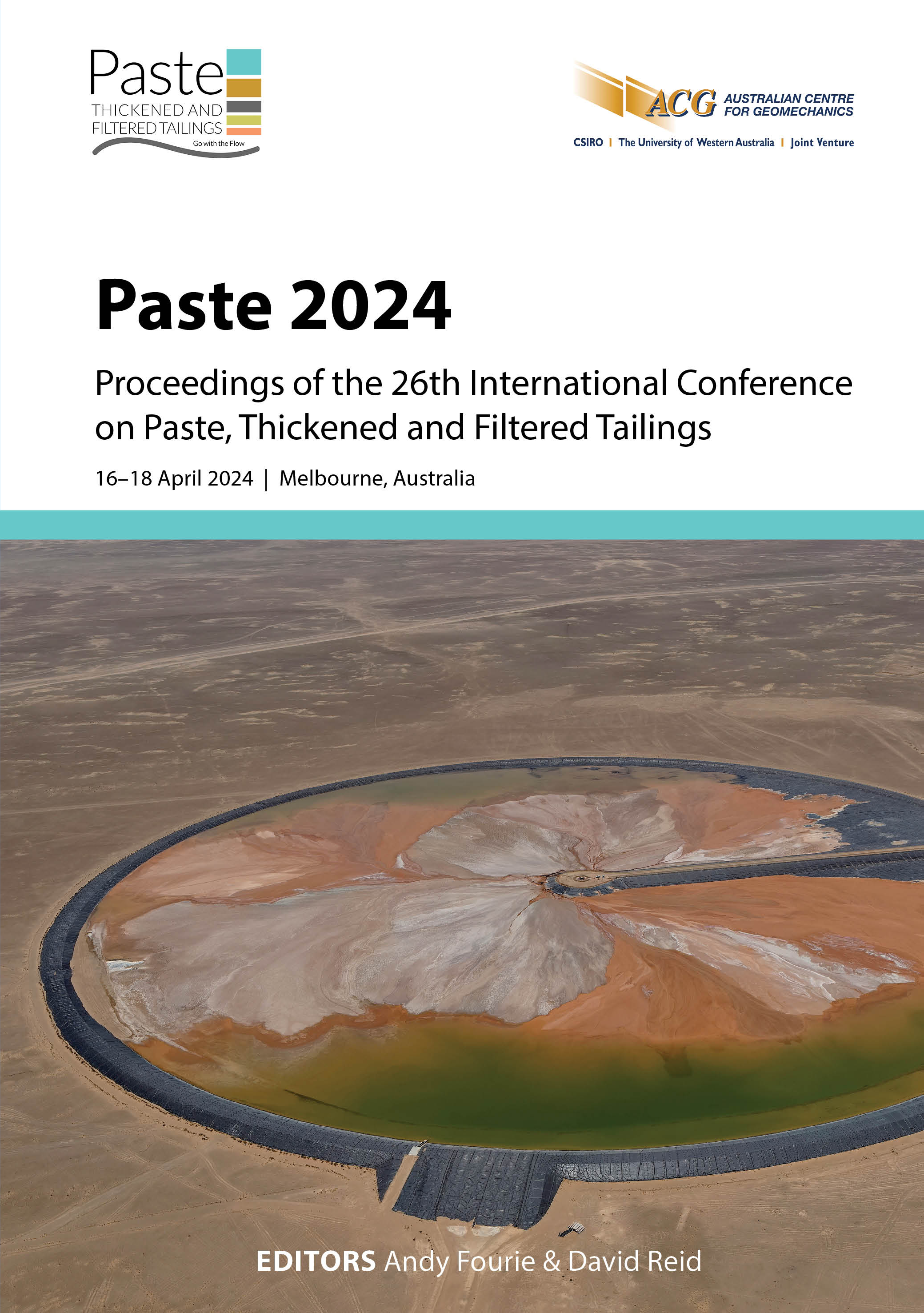Exploring the role of time-dependency in tailings deposition flows

|
Authors: Talmon, AM; Nabi, M; Meshkati, E |
DOI https://doi.org/10.36487/ACG_repo/2455_21
Cite As:
Talmon, AM, Nabi, M & Meshkati, E 2024, 'Exploring the role of time-dependency in tailings deposition flows', in AB Fourie & D Reid (eds), Paste 2024: Proceedings of the 26th International Conference on Paste, Thickened and Filtered Tailings, Australian Centre for Geomechanics, Perth, pp. 257-270, https://doi.org/10.36487/ACG_repo/2455_21
Abstract:
In the field of fluid dynamics, initial focus is often placed on steady flow conditions. However, an intriguing phenomenon emerges when we observe that flow behaviour in deposits can be time dependent. While the deposition of coarse particles might seem an obvious contributor to this phenomenon, it’s important to note that time-dependent flow also occurs in flocculated or coagulated, fine, non-settling materials. This prompts us to explore the possibility of time-dependency in homogeneous non-Newtonian fluids, considering two key aspects: changes in rheological properties and variations in fluid flow characteristics over time. An initial comparison by Talmon et al. (2023) of two different time-dependent rheology models revealed similar behaviour but also showed intriguing differences in numerical calculation of beach deposition’s straight channel flow, which demanded further investigation. We reveal the origin of differences, recalculate and converge results. These two models concerned reversible time-dependency, e.g. thixotropy. Rheomalaxis, e.g. irreversible time-dependency of rheological properties, will be addressed too. With shear thinning of tailings, deposition conditions appear prone to the development of surface waves. The flow conditions in open channel flow experiments and a tailings flume deposition trial are analysed by means of numerical fluid flow simulation (time-independent rheology) and indeed, surface level variations are calculated. This corresponds qualitatively with observed variation of plunge pool level and irregular flow. Tailings are flocculated to speed up dewatering. Our studies show that it is also necessary to quantify associated time-dependent rheological properties because flocculation highly influences deposition flow. Our calculations show that flocculation affects both the depth of streams as well as their velocity. In 3D, relating to earlier devised analytical channel formation theory (Talmon 2023), it may initiate pattern formation and affect run-out distances. Dedicated flocculation might be a way to influence and manage deposition; when we better understand the flow path of the material.
Keywords: tailings storage facility, rheology, thixotropy, rheomalaxis, computational fluid dynamics, free surface waves, validation
References:
Charlebois, LE 2012, On the Flow and Beaching Behaviour of Sub-Aerially Deposited, Polymer-Flocculated Oil Sand Tailings: a Conceptual and Energy-Based Model, BSc thesis, University of British Columbia, Vancouver.
Chow, VT 1959, Open-Channel Hydraulics, McGraw-Hill, New York.
Coussot, TP 1994, ‘Steady, laminar, flow of concentrated mud suspensions in open channel’, Journal of Hydraulic Research, vol. 32, no. 4, pp. 535–559.
Fitton, T 2007, Tailings Beach Slope Prediction, PhD thesis, RMIT University, Melbourne.
Haldenwang, R 2003, Flow of Non-Newtonian Fluids in Open Channels, PhD thesis, Cape Technicon, Cape Town.
Houska, M 1981, Engineering Aspects of the Rheology of Thixotropic Liquids, PhD thesis, Czech Technical University, Prague.
Moore, F 1959, ‘The rheology of ceramic slips and bodies’, Transactions British Ceramic Society, vol. 58, pp. 470–494.
Oliveira Ferreira, F de, Freitas Maciel, G de & Batista Pereira, J 2021, ‘Roll waves and their generation criteria’, Brazilian Journal of Water Resources, vol. 26, no. 10, p. 202.
Parent, E & Simms, P 2019, ‘3D simulations of dam breach and deposition using viscosity bifurcation rheology’, in J Goodwill, D van Zyl & M Davies (eds), Proceedings of Tailings and Mine Waste 2019, Vancouver.
Pirouz, B, Javadi, S, Williams, P, Pavissich, C & Caro, G 2015, ‘Chuquicamata full-scale field deposition trial’, in R Jewell & AB Fourie (eds), Paste 2015: Proceedings of the 18th International Seminar on Paste and Thickened Tailings, Australian Centre for Geomechanics, Perth, pp. 477–489,
Ponce, VM 1991, ‘New perspective on the Vedernikov number’, Water Resources Research, vol. 27, no. 7, pp. 1777–1779.
Sisson, R, Lacoste-Bouchet, P, Vera, M, Costello, M, Hedblom, E, Sheets, B,…Sittoni, L 2012, ‘An analytical model for tailings deposition developed from pilot-scale testing’, in DC. Sego, GW Wilson & NA Beier (eds), Proceedings of the 3rd International Oil Sands Tailings Conference, Edmonton, pp. 53–63.
Sittoni, L, Talmon, AM, Hanssen, JLJ, Es, H van, Kester, J van, Uittenbogaard, R, Winterwerp, JC & Rhee, C van 2016, ‘Optimizing tailings deposition to maximize fines capture: latest advance in predictive modeling tools’, in DC Sego, GW Wilson & NA Beier (eds), Proceedings of the 5th Int. Oil Sand Tailings Conference, IOSTC, Lake Louise.
Talmon, AM, 2023, ‘Bed pattern initiation in non-Newtonian laminar deposition flow’, in RS Sanders & J Schaan (eds), Proceedings of Hydrotransport 2023, Edmonton (in press).
Talmon, AM & Meshkati, E 2023, ‘Houska based time-dependent rheology model for flocculated tailings’, in J Sobota & B Malczewska (eds), Proceedings of the 20th International Conference on Transport and Sedimentation of Solid Particles, Wroclaw,
pp. 193–205.
Talmon, AM, Meshkati, E, Nabi, M, Simms, P & Nik, RM 2023, ‘Comparing various thixotropic models and their performance in predicting flow behavior of treated tailings’, in GW Wilson, NA Beier, DC Sego, AB Fourie & D Reid (eds), Paste 2023: Proceedings of the 25th International Conference on Paste, Thickened and Filtered Tailings, University of Alberta, Edmonton, and Australian Centre for Geomechanics, Perth, pp. 588–600,
Talmon, AM, Meshkati, E, van Kessel, T, Lelieveld, T, Goda, APK & Trifkovic, M 2021, ‘On thixotropy of flocculated mature fine tailings: rheometry and lumped structure parameter modelling’, in NA Beier, GW Wilson & DC Sego (eds), Proceedings of Tailings and Mine Waste Conference, Banff.
Talmon, AM, Hanssen, JLJ, Maren, DS van, Simms, PH, Sittoni, L, Kester, J van, …. Rhee, C van 2018, ‘Numerical modelling of tailings flow, sand segregation and sand co-deposition: latest developments and applications’, in NA Beier, Wilson GW & DC Sego (eds), Proceedings of the 6th International Oil Sand Tailings Conference, IOSTC, Edmonton.
© Copyright 2025, Australian Centre for Geomechanics (ACG), The University of Western Australia. All rights reserved.
View copyright/legal information
Please direct any queries or error reports to repository-acg@uwa.edu.au
View copyright/legal information
Please direct any queries or error reports to repository-acg@uwa.edu.au
